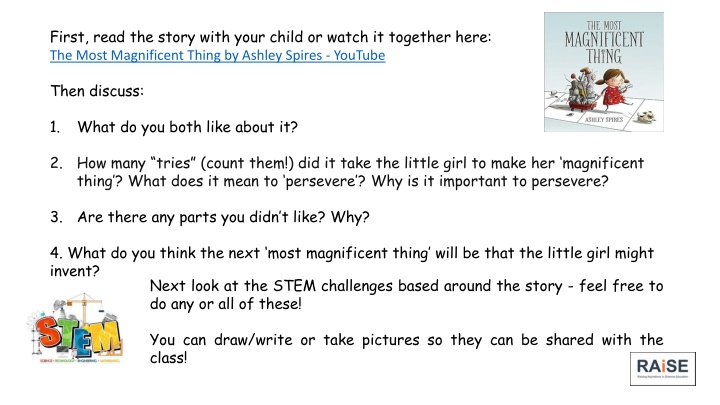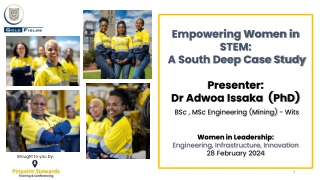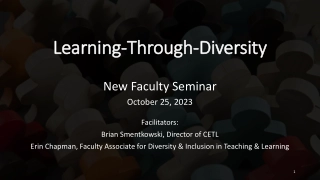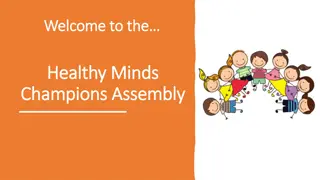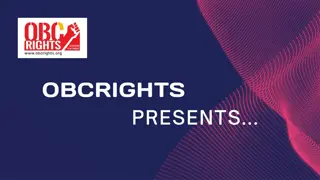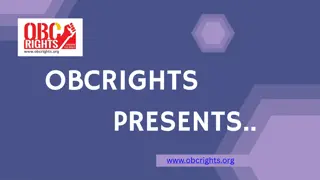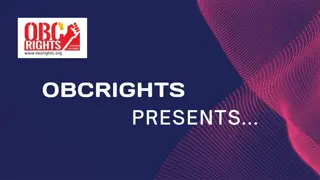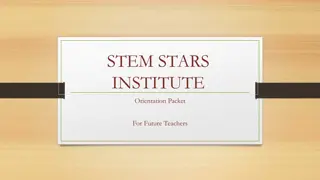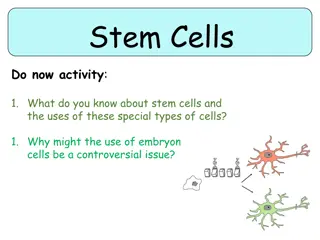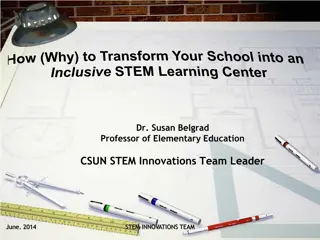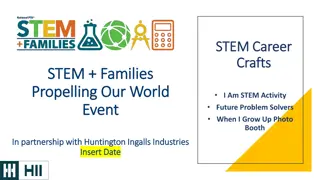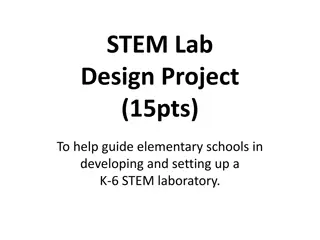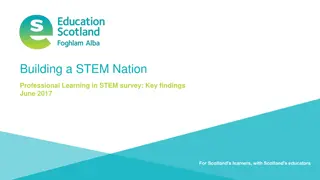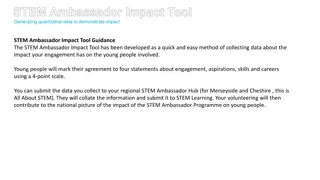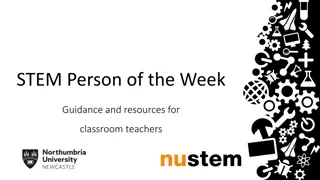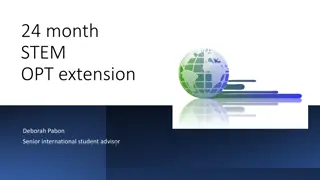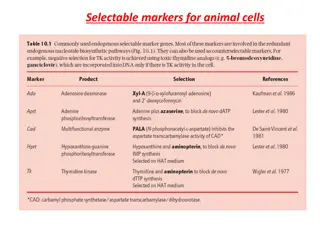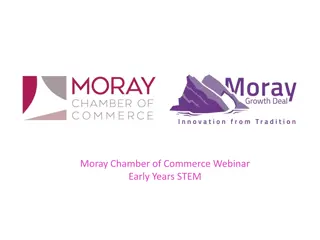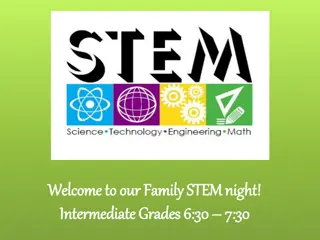STEM for Young Minds: The Most Magnificent Thing Activities
Foster STEM skills in children by exploring engineering and design challenges inspired by "The Most Magnificent Thing" story. Engage in hands-on experiments, such as exploring friction, designing pet assistant robots, creating recycled inventions, and crafting safety helmets. Encourage creativity, problem-solving, and critical thinking through fun STEM activities at home. Share your creations with the class and inspire curiosity in science, technology, engineering, and math.
Uploaded on Mar 03, 2025 | 1 Views
Download Presentation

Please find below an Image/Link to download the presentation.
The content on the website is provided AS IS for your information and personal use only. It may not be sold, licensed, or shared on other websites without obtaining consent from the author.If you encounter any issues during the download, it is possible that the publisher has removed the file from their server.
You are allowed to download the files provided on this website for personal or commercial use, subject to the condition that they are used lawfully. All files are the property of their respective owners.
The content on the website is provided AS IS for your information and personal use only. It may not be sold, licensed, or shared on other websites without obtaining consent from the author.
E N D
Presentation Transcript
First, read the story with your child or watch it together here: The Most Magnificent Thing by Ashley Spires - YouTube Then discuss: 1. What do you both like about it? 2. How many tries (count them!) did it take the little girl to make her magnificent thing ? What does it mean to persevere ? Why is it important to persevere? 3. Are there any parts you didn t like? Why? 4. What do you think the next most magnificent thing will be that the little girl might invent? Next look at the STEM challenges based around the story - feel free to do any or all of these! You can draw/write or take pictures so they can be shared with the class!
What is STEM and why is it important? STEM stands for science, technology, engineering and maths. These subjects give young people important skills for their future lives and work. The skills which come from doing STEM subjects are used in many different jobs: from cooking to commerce; finance to farming; apps/game development to animal welfare and brewing to building. Some jobs might be STEM-specific, for example developing new food and drink products or calculating the likelihood of rain tomorrow. Others might be in a STEM-type workplace, for example a librarian in a medical school or a lawyer in an energy company. Whether or not young people end up working in a STEM job or workplace, they need the skills which STEM subjects give them. Employers are looking for young people with these skills, but there s a big shortage (skills gap). You can find out more here: Supporting science, technologies, engineering and mathematics (STEM) at home | Learning at home | Parentzone Scotland | Education Scotland You can foster STEM skills at home by encouraging observation, curiosity, creativity and problem-solving and by building simple projects using household items/recycled materials; examples of the kinds of activities that could be done to help support STEM learning at home are those suggested in this pack. Look at the STEM challenges based around the story, feel free to do any or all of these! You can draw/write or take pictures so that you can share these with your class! We would love to know how you got on if you would like to, please write a comment in the feedback sheet
Science Engineering What will happen if the little girl rides her invention along a bumpy road? Will it be easy? It's easier to roll fast on some surfaces but there's something that slows you down when it isn t smooth! It s called friction! Let s do an experiment to find out about friction! (please see next page) The story illustrates the Engineering Design Process: the girl has an idea about something that will make something better, or a challenge and she sets out to build the solution that she can picture, then there are many rounds of building, evaluating, and building again to improve the design. This is Engineering Design Process in action! testing and the Engineering & Design The little girl has a dog for an assistant who looks a bit like a robot! Design another pet assistant robot; what does it do to help the little girl? You can draw your design or make it out of recycled materials and take pictures! The Most Magnificent Thing The Most Magnificent Thing was created from recycled things. Collect scraps of paper and things you would normally throw away (make sure they re clean!) Make or build your own Most Magnificent Thing for your bedroom or for the classroom with the items. Think about its purpose and how it is going to improve or solve a problem. Or you could draw your idea and label it, explaining what it is for. Engineering & Design Can you design a safety helmet for the little girl for her to wear when she rides on her invention (a scooter that allows her dog to ride with her!)? You can draw it and label all the different parts and its special features! You can do any or all of these STEM activities! Have fun!
Lets find out about friction! Friction is a force between two surfaces that are sliding, or trying to slide, across each other. Friction always works in the direction opposite to the direction in which the object is moving or trying to move. Friction always slows a moving object down. The amount of friction depends on the materials from which the two surfaces are made: the rougher the surface, the more friction is produced. We are going to: build a ramp roll something down it see how far it rolls do some testing You will need: 1. Something with wheels - a toy car or anything that rolls! 2. A ramp - build your own out of cardboard, books and a chopping board, or however you like! 3. Two or more different surfaces in your home. Maybe your living room has a carpet, and your kitchen floor doesn t? 4. Something to measure with: a tape measure, ruler, or you can just use the length of your hand. 5. Paper and a pen/pencil to write down your results. Instructions 1. Build your ramp: How steep are you going to make it? Are you going to make it big or small? 2. Test your ramp: put the car at the top of the ramp and let it go. How far does the car go along the floor? Now move it onto the other surface and repeat. Which surface was bumpier? Which surface did the car go furthest on? Does friction speed things up or slow things down? Which surface had more friction?
How did you feel using this pack? We would love to know how you got on and what you thought about this pack. If you would like to give us some feedback, please either click on the link or scan the QR code and complete the very short questionnaire. Thank you A paper copy is available too if you would prefer to complete the questionnaire that way. https://forms.office.com/e/KVNihmz7E2
How did you feel using this pack? You Adult Any other comments? Do you have any ideas for other story books to use for STEM challenges/activities?
Some of the Curriculum for Excellence Experiences and Outcomes that these activities may cover The Most Magnificent Thing Curricular area Outcome Technologies Design and Construct Models/Products TCH 0-09a/1-09a/2-09a Representing ideas, concepts and products TCH 0-11a/1-11a/2-11a I can explore and discover engineering disciplines and can create solutions TCH 0-12a/1-12a Science Through everyday experiences and play with a variety of toys and other objects, I can recognise simple types of forces and describe their effects. SCN 0-07a By investigating forces on toys and other objects, I can predict the effect on the shape or motion of objects. SCN 1-07a By investigating how friction, including air resistance, affects motion, I can suggest ways to improve efficiency in moving objects. SCN 2-07a Art and Design Working on my own and with others I use my curiosity and imagination to solve design problems EXA 0-06a I can use exploration and imagination to solve design problems related to real life situations EXA 1-06a Literacy I enjoy exploring events and characters in stories and other texts, sharing my thoughts in different ways. LIT 0-01c Literacy To help me understand stories and other texts, I ask questions and link what I am learning with what I already know. LIT 0-07a / LIT 0-16a I can show my understanding of what I listen to or watch by responding to and asking different kinds of questions. LIT 1-07a
